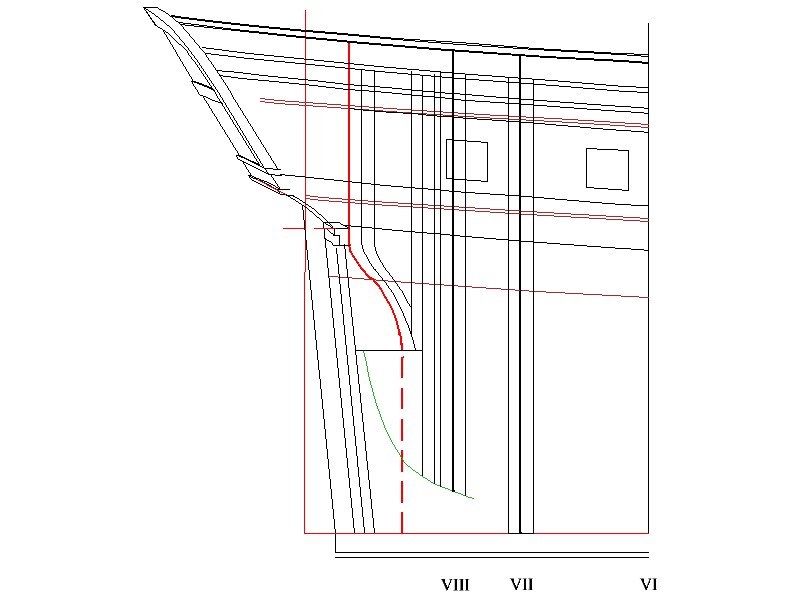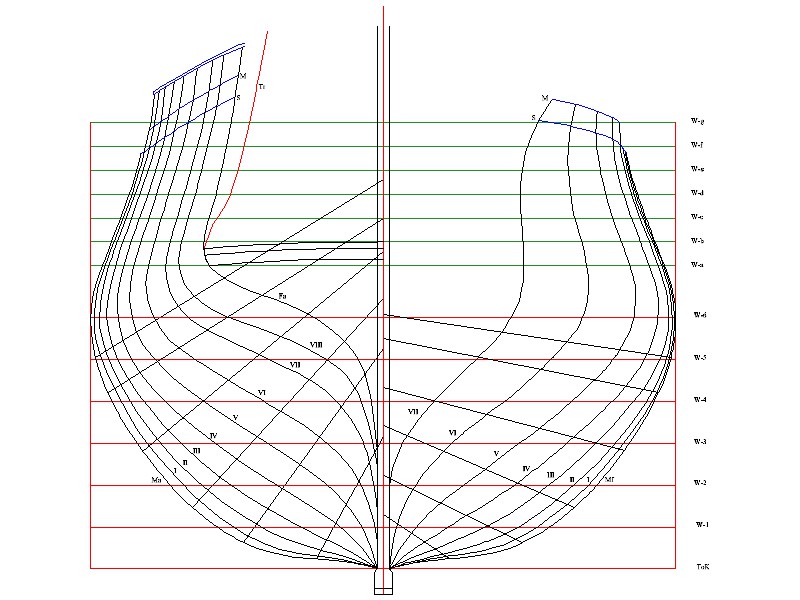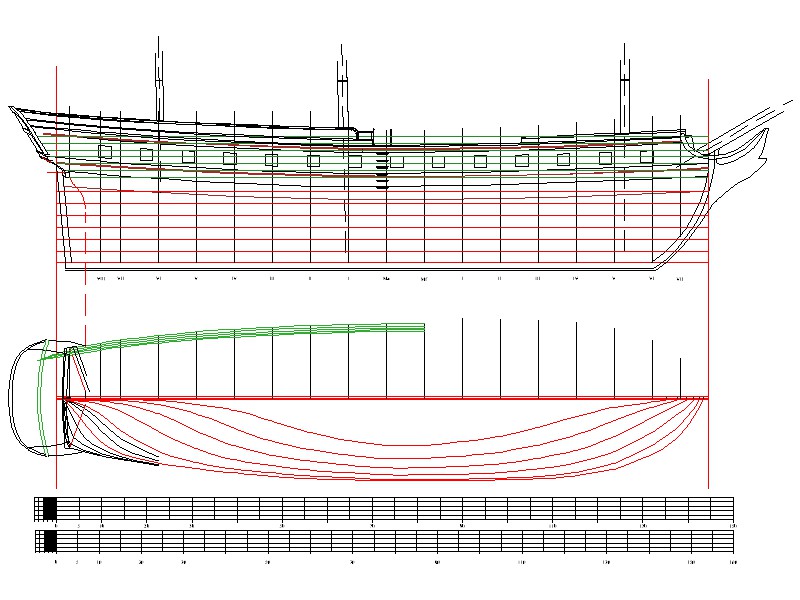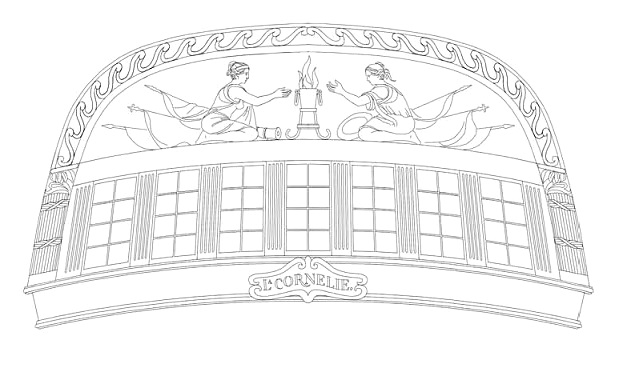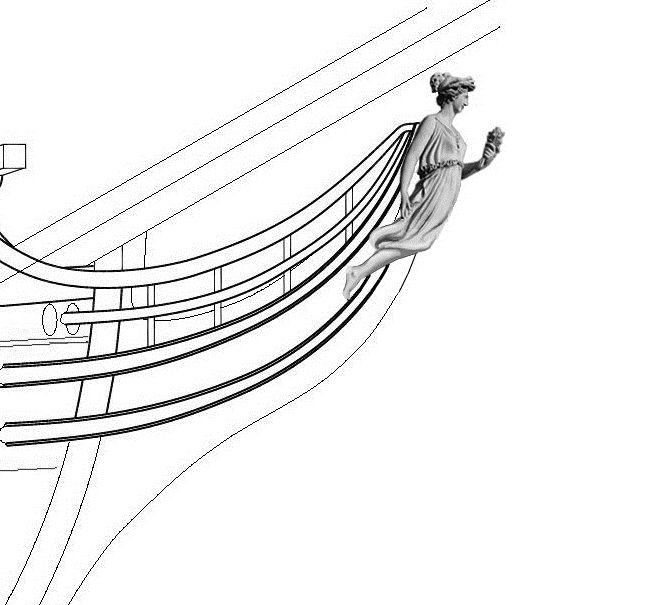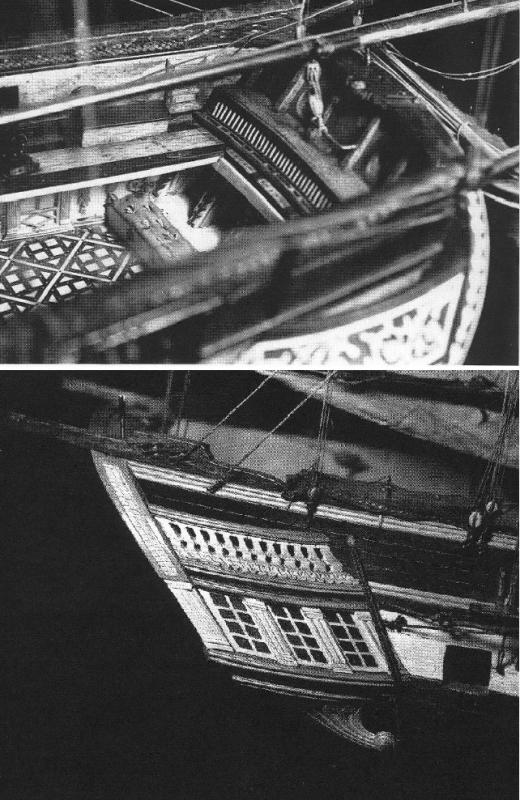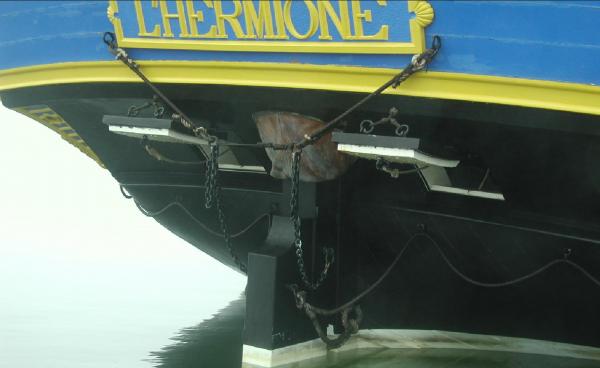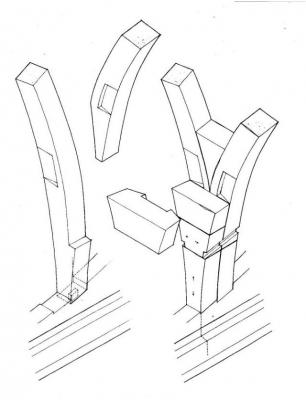-
Posts
309 -
Joined
-
Last visited
Content Type
Profiles
Forums
Gallery
Events
Everything posted by JohnE
-
Hi Mark. Many happy returns, young man. Check out rybakov’s post #3 on http://modelshipworld.com/index.php/topic/716-hammocks-cranes-and-covers/ Admittedly a couple decades after your Licorne, but it suggests that your gallery upper finish was known and used, although apparently it wasn’t all that pervasive. I know the aft end of the railing takes a hard turn and runs straight to the hull, but I can envision a more elliptical shape. As to the straight line in the drawing, I do not know, but opine that it has to be some interior structure (against the hull) associated with the gallery ‘tub’ finish, since it spans the end-points of the curvature of the top gallery rail. I think druxey has it – the line of the hull edge of the interior ‘lining’ of the ‘tub’, ‘bin’, or what have you. But this is just an opinion. I know you will do what you think best, and it will be appropriate and well executed. Ciao. John
-
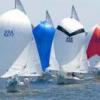
Frégate d'18 par Sané , la Cornélie
JohnE replied to JohnE's topic in CAD and 3D Modelling/Drafting Plans with Software
Thank you all. Appreciate it a lot. I’ve generated offset tables for the horizontals; waterlines, topsides, deck lines, and lines of the sheer and main rails based on the reconstructions of the body plan curves. I use a particular definition of the placement of the line of the fashion frame (lisse d’estain), and thought it appropriate to include an explanation with the offset tables. But also thought it nice to include it here, such as it is. The basic French station line bisects the corresponding couple. L’estain is also a ‘couple’. The aft fashion has an aft edge, the forward fashion has a forward edge and there is a centerline where the two frames join. Different designers used different lines; some using the aft edge, some using the centerline. I chose to use the aft edge and had to make sure the body and water lines conform to the choice. Here is a very simplified frame drawing showing position of the lines in profile. The red dashed line is really just a projection down. The physical aft fashion stops where the heel rests on the deadwood of the massif. The massif also has some surface contour and defines/continues the lower portion of the fashion frame’s body line. There is nothing much behind l’estain to define measurement locations in profile. The filling transoms live in the space behind the lazy s. Behind l’estain’s upright top timber edge are filling timbers that go back to the side counter timber, leaving room for the door to the head. So, l’estain is truly the aftermost “line of reference” of the profile that defines lines in the other orthogonal views (the stern rabbet notwithstanding since it simply defines termination points for lower waterlines). John -

Steamboats and other rivercraft - general discussion
JohnE replied to Cathead's topic in Nautical/Naval History
Prompted childhood memories for me as well. When I was 12 (1961??, wow) I stayed a summer with grandparents in Wiesbaden and one day Omi and I took a Köln-Düsseldorfer paddle steamer excursion to Sankt Goarshausen and back. I, too, was engrossed with the engines. So much so that I almost missed Die Loreley. I think there is still one of those remaining in K-D service, Goethe, that looks much of a muchness with the Lake Lucerne paddle steamers. I do agree, one of these would make a marvelous model. J- 281 replies
-
- Steamboats
- riverboats
-
(and 3 more)
Tagged with:
-

Frégate d'18 par Sané , la Cornélie
JohnE replied to JohnE's topic in CAD and 3D Modelling/Drafting Plans with Software
Well then, druxey noticed some inconsistencies in the transoms, Bava noticed some inconsistencies in the topsides, and I found a couple others. So I did a Chapelle. By that, I mean proving the lines in all views so as to have them 'fair' and let the offsets fall where they may. So I did that and 'lo' I can drop this girl into a Boudriot book and have her go unnoticed. I fought with the topside lines (made some specific horizontals) and then plotted the results as 'special' waterlines (a la Boudriot) and worked things iteratively till ... it necessitated a bit of tweaking for certain stations at the top waterline, but hey, what's CAD for anyway. The topsides are smooth and fair; no bumps or hollows. And the lines connect up with the gallery top view, within a half pouce. Pretty good. I ran everything through my NACA Matlab program and the results are striking. I don't want to use a modern curve-fit program, for obvious reasons, but it's nice to know that a yard dog's batten was sweet. So, final, final, on the body plan and the half breadth. So final that I made a table of offsets. Talk about commitment, Woof. Offsets are in French pieds, expressed in decimal. Next column is the same measurement in decimeters. It's in 4 sig-figs, so going to millimeters is brainless. Plans are drawn in 1:12. Oh yeah, S is the line of the sheer rail; M is the line of the main rail (hemi, demi, semi, equivalent to the English top-timber line). -
Ok. Not the best idea. Was just saying. And I can see the down side to it. J
-
Reminded of a story. A Friday nite beercan from Rush Creek to Chandler's Landing and back. It was dusk, and flat. We had rounded and were ghosting with the kite in 'maybe' 3-4 knots. Upwind comes a Harmony 24 who just dropped her genoa. A young boy was on the bow, covered with lines and draped with the sail. It was a silent kind of evening, and over the water floats this plaintive little voice saying "Daddy .. what the sh*t do I do now?" Thus it is with first time anything. I appreciate and agree with Chris' cautionary tale. However, I think that we, as a community, might extend the paradigm a bit. One doesn't tell a landsman that he is on the fore topmast. It takes time and help (yes, and training) to get anywhere in an area as complex as this can be. Some of our threads are populated by people that are the equivalent of Olympic, America's Cup, or Volvo champions. Pity the young foredeck monkey. Can we make a separate space for first-time, intermediate, modellers, where they can post and ask, and we can help and comment, without their being intimidated by competing with some of our member's exquisiteness? I know this is not politically correct, and has implications for being on 'the second tier', but someone who is truly interested in the 'hobby' and wants to learn and grow, may find it useful. Just saying. Ciao. John
-

Frégate d'18 par Sané , la Cornélie
JohnE replied to JohnE's topic in CAD and 3D Modelling/Drafting Plans with Software
And then, following the paradigm of reconstruction, the artist did a cove carving that was too perfect for words. The ‘original’ Cornélie had a note of a busy cove carving that may not have been done in actual practice, but looked good in dockyard records. Since this ship is not of the ‘original’ Cornélie , it seemed good and right to let the artist have the freedom to play. This was the result: Cornelia and Vesta offering, together, to la flamme sacrée. It is right in line with the figurehead. Oh, gosh, an artist that “knows” ships as well as “knows” his Greek and Roman. Life doesn’t get any better. Ciao John -

Frégate d'18 par Sané , la Cornélie
JohnE replied to JohnE's topic in CAD and 3D Modelling/Drafting Plans with Software
Have a sneak peak of the carvings. The only known reference to the carvings of the “real” Cornélie is a few sentences in dockyard records. Not much to go on, but her figurehead was described as Cornélie, “hair bound in roman fashion and holding a vessel of the sacred flame”. Cornelia Scipionis Africana, mother of the Gracchi, was the touchstone of motherhood virtue (home and hearth) in Rome; the only woman who ever got a statue in the forum. She refused the marriage proposal of Ptolemy Physcon, who offered the crown and treasures of Egypt, by bringing out her sons and saying “These are my treasures.” Who would not love a ship named for such an incredible woman. The Roman goddess of motherhood (and virtue, and other stuff) was Vesta (the Greek Hestia) who was keeper of the sacred flame of home and hearth and virtue. Her statues and images show her holding a ‘vessel’ of the sacred flame. Some of these are brass cups having the flame, but most are of the ice cream-cone shaped bundle of rods with la flamme sacrée issuing from the top. Since I can’t draw, one of our members and contributors offered to come and play. He did the perfect figurehead. Can’t begin to say how well this works. -

Frégate d'18 par Sané , la Cornélie
JohnE replied to JohnE's topic in CAD and 3D Modelling/Drafting Plans with Software
That is a rather nice phrase, isn’t it? I have learned so much from Howard Chapelle’s and Merritt Edson’s notes and journals about the techniques of ‘reconstruction’. To name the process for Chapelle seemed the fair thing to do (pun intended). Better lines plans coming very soon. They will be accompanied by some Excel files that have the table of offsets, separately, for the underwater waterlines and the additional topsides horizontals. Excel data points are in ‘decimal’ French pieds with a next column in metric. It’s ‘decimal’ pieds because TCAD works in decimal and it’s not all that hard to go between ‘decimal’ pieds and pieds/pouces/lignes. I used some of Chapelle’s technique suggestions and math and I will be dipped if the topsides didn’t simply drop into the Chaumont Draught paradigm. Not too many changes, but I’m afraid Mademoiselle l’estain got tweaked (I have as much trouble with that as you, Bava, but I think I have her worried). Ciao John -

Frégate d'18 par Sané , la Cornélie
JohnE replied to JohnE's topic in CAD and 3D Modelling/Drafting Plans with Software
Soon, my friend, soon. You have tweaked me right where the sharpie should go. I'll get you something a bit more righteous. Ciao. John -

Frégate d'18 par Sané , la Cornélie
JohnE replied to JohnE's topic in CAD and 3D Modelling/Drafting Plans with Software
Been a while, but a lot has been going on. A 3D modeler (Bava) noticed some inconsistencies in topside lines for orthogonal views. These had to be fixed. That’s one of the witches of working with the original 1810 offset tables; they are not self-consistent. Ok, what the hey, I figured I would have to do a Chapelle at certain points, but basic departures from the offsets? Woof !!! The underwater lines conform nicely all the way from Boudriot’s 1782 Venus to the 1821 Armide, with appropriate adjustment to the principal dimensions according to the “reglement”. It’s topsides that are biting the big one. Reconciling curves don’t really reconcile; perhaps they do for a couple of stations, but then they depart. This period was one of transition, and it’s very hard to a good grip on this for a ship of “general” configuration. The whole tumble home thing was undergoing the same examination as for the British, but not quite to the same extent. Cornelie’s topside lines are way outside the Venus, and way inside the Armide. They are close (but no cigar) to the Rochefort Justice, the Chaumont Sane, and the Sane Erigon. Mathematics is indicated. AAaarrrggh !! Can do this. Ciao. John -
Elle est magnifique ! Il n’y a pas de mots suffisants pour décrire la beauté. Tu es vraiment un maître artisan (sorry for the familiar). There are not words sufficient to describe the perfection of detail of your build of this beautiful vessel. You are truly a master craftsman in every respect. Cordialement, John
- 728 replies
-
- le fleuron
- 64 gun
-
(and 1 more)
Tagged with:
-
I am the last guy in the world to challenge Gerard Delacroix or Gaetan Bordeleau, but I believe the Belle Poule is not quite appropriate in this specific instance. A major repair/rebuild would have had to happen at least a decade and a half after launch. That takes her to ~1770, long after Caffieri's death and during Lubet's heavy handed minimalism. 1770 would put her right at the end of the first 12-pdr build program and just a few years ahead of the 1775 monster build program. Given the chaos of this transitionary period, and the fact that she was a major repair/rebuild, it is hard to wrap my head around a designer draught, no matter how similar the vessel. Just look at NMM draughts of a French ship 'as captured' and the same ship after a couple months (or less) in a Brit dockyard (the differences are beyond striking). Yard dogs are sensitive creatures. Once they get used to doing something one way, then, hey, that's kinda what ya gonna get for everything else. Ok, so I'm cynical. You could do a Belle-Poule, and I know it will be gorgeous and proportioned just right. But besides being cynical, I'm also a butt-head. Just saying. No worries either way, Mark, my Commodorable whacks me up the side of my head as often as she thinks I need it. Which is a bit more often than I'm wanting to own up to, but likely a teensy bit less often than I really need. Ciao. John
-
Mark, I think you are on the right track. Druxey likely found the same stuff I have. Even some bottle-style quarter galleries had a cup-like bin at the tippy top, judging from drawing shadows and perspective. After Caffiere, there was radical change in gallery design and by 1780 you saw all kinds of stuff for the gallery upper-finish; flat closed roofs, angled roofs with or without carving, and roofs with ‘rails’, forming a bin for MOB gear or a cistern, or whatever. The 1787 Vial du Clairbois shows a ‘roof bin’ finish with respect to 74s. Frigates would not have been substantially different. The 1785 Calypso had ‘rails’, Proserpine did not (just finish roof carving). Admittedly, the photos are of models of 1800 and 1804 ships, but show the idea of how the ‘rails’ extend outside the side of the hull, so you can see how it goes. Boudriot notes there was even a canvas shelter top that deployed over the top of the bin and notes the doorway (small) cut into the bulwark, way aft, for access (at least in La Flore). Your NMM plans show a feature that I would consider dispositive, although there is lots of room for disagreement. The top line of Licorne’s quarter gallery finish is a curve. This curve is displaced from the line of wale and line of rail, and has a curvature that cannot be reconciled with some older sheer line of the vessel. Other ships that had a simple, ‘railless’, roof finished by being faired to and flowing into the corresponding sheer or main rail. . Licorne’s is clearly something that curves outwardly from the hull surface in this area, as shown by other ‘bin-top’ vessels. The rail slopes inward and can be an open rail (not usual), or lined with lead or canvas (typical). The underlying physical roof structure will be a skoosh flatter – wood, lead covered. Hard to know the actual roof angle, but Vial gives the proportion of 2/3 the overall rise for a 74. Licorne is also unusual in that the after edge of the finish does not connect with the cove (horseshoe). This suggests a “dome-like” roof which was very common for the period and might well be an artifact of the bottle roof. For a rebuild, a yard dog would very likely take the path of “save what you can, and use what you save”, but this is pure speculation. Enough of my blithering. I hope this helps somewhat. Ciao. John
-
Janet is in my prayers; you are too. There are candles burning to St. Theophilus for both of you. Wood looks good! Discovered a fiddly-bit from working with the carving artist for Cornelie. Make the wood just a skoosh thicker and then do the carving indents. When you are done with the carvings, shave the body to its perfect lines. The result is a skoosh more scale looking carving with respect to depth. Yeah, I know, magnifying glasses and the dental tip to sharpen up the edges, but what the hey. Just a thought. Ciao. John
-
My 2 centimes. The vessel should have a story; some fame or provenance that would make her interesting and exciting for a general model maker. There’s lots of very good offerings in previous posts. But I feel that Euro ships are under, or, un-represented in the world of kits. Western folks have little opportunity to explore the history and detail of a Euro vessel, as it differs from the typical British or American model. So, I would like to see something Spanish, but not the usual huge and ornate 1st rate. Perhaps a frigate from the treasure fleet of Cabo de Santa Maria (Oct. 1804) Fama, or perhaps Nuestra Señora de las Mercedes Spain: 1790-1805 PoF or PoB (could be a plan option). Decent wood (but one is able to substitute). Scale is indeterminate due to Euro metrics, but something consistent with 1:48. Consistent scaling is all important, such that Chuck doesn’t have go broke with stocking charges for a gazillion different scales. Consistent scaling is also extremely important for modelers looking to do matched-pair builds (Fama/Lively, Chesapeake/Shannon, Mercedes/Amphion, etc..). At 1:48, I would expect to pay $600-$800 (680-900 Eu) for a good quality PoF kit with suitable wood and full-boggie plans (suitable for kit-basher builders). PoB should be less by roughly $115 (100 Eu). The kit could be scaled down to 1:72 and done PoB for $350-$450 (300-400 Eu). At 1:48 PoF, it’s kinda advanced going to full-boggie advanced if one delves deeply into the treasures of the plans. With PoB, it’s intermediate (+) going towards advanced. Best case, 9-mos to 1-year. Full-boggie is however long you can convince the Admiral you admire the flow of those lines as much as, if not more, than your vessel.
-

Caroline's bottom
JohnE replied to GrantGoodale's topic in Building, Framing, Planking and plating a ships hull and deck
Certainly agree Druxey. Was just pinging on terminology back then. John -

Caroline's bottom
JohnE replied to GrantGoodale's topic in Building, Framing, Planking and plating a ships hull and deck
I knew a Caroline once and ... um ... sorry. From 1650 to 1730, various desultory experiments were made with sheathing techniques and materials, including planking arrayed with copper studs. After the ship launched, it didn’t take long for the copper to turn green. The French called the overall effect ‘petit pois’. I can see the English calling it pease. Have no clue whether this is the ‘pease’ bottom Druxey speaks of. It’s just that the name caught my attention and got me going. Masseille, H. Notes sur la sallsure et les procédés d'entretien des carènes Immergées. Peintures Pigments Vernis, Vincennes, 1933. John -
You might look into Les Editions du Petit Vincent : Reedition d’ouvrages a l’ancienne. http://www.editions-petit-vincent.com/ owned and operated by Herve Sasso, who is also the webmaster for Gerard Delacroix’s Marine et Modelisme d’Arsenal. He has beautifully bound, full size and complete, transcriptions/reprints of Ollivier’s Traite de Construction (somewhat expensive) as well as smaller sized paper bound versions that are very reasonably priced (~45.00 Eur). The main transcription work is by Gerard Delacroix who published his monograph of Fleuron after careful study of Ollivier’s text. I think Gaeten Bordeleau is right – you will probably need this. John
-

Frégate d'18 par Sané , la Cornélie
JohnE replied to JohnE's topic in CAD and 3D Modelling/Drafting Plans with Software
Sorry for delays. Got a nice new 3D program but it needs OpenGL 3.0 or more. My legacy system has 1.7. Looked for a nice graphics card and found my power supply wasn't up to snuff. So new computer. Oh ... My ... God .. !!! Can you say Woof .. !!! I'm migrating slowly since all my disc boxes have SN and Activate keys on them, but I have no clue which tag goes to which version. Fortunately I register and folks at Corel and IMSI are very gracious once you get to them after 3 or 4 trips through the phone root extraction profile (pushing the wrong button). Soon, soon. Will have to make a pitcher of Uncle John's Famous Baja Margaritas and fire up Master and Commander. This is just to recover my Wa, you understand. John -
It's just like Mark said. The craftsmanship is simply impeccablr. I also like your model paradigm. I can imagine Hardy sitting in the stern with his cheeks strewn with tears remembering the last voyage of his great captain on just such a vessel. Thank you druxey for a build that is not only perfection, but also historically significant. John
- 641 replies
-
- greenwich hospital
- barge
-
(and 1 more)
Tagged with:
-
Hi ya Mark, Found a pic I took of l'Hermione's rudder coat and the security chain details. I think your present coat looks darn good, but if you want to do a re-do, a picture might be worth something to you. I know l'Hermione was 25 years after Licorne, but things didn't change all that quickly, back then. It's greased, sewn, leather. The maitre d'equipage (sailing master/bosun) says it's quite rugged, long-wearing, and flexible, so long as it's conditioned/greased regularly. Today, they use a Lexol type conditioner, but back in the day they would use the grease skimmed of the top of the soup vats (like British Navy slush) and hang poor Pierre out the stern port with a bucket of the stuff and a hand mop. John
-

Frégate d'18 par Sané , la Cornélie
JohnE replied to JohnE's topic in CAD and 3D Modelling/Drafting Plans with Software
Ok, so things are getting exciting. To really get a handle on the shape of the buttocks, I am going to have to do some lofting. That means defining some timbers/frames and doing some fairing. I will be using Vial du Clairbois as my basis just as Boudriot did for his 74-gun ship. I kown this is a frigate, but I think I can scale appropriately given Sane's box rules in his Devis, and Vial's very clear exposition as to shape and placement. Simple geometry and trig and logarithms, and bears, oh my. Stay tuned. John -

ancre Le Rochefort 1787 by Niklas - 1:36
JohnE replied to Niklas's topic in - Build logs for subjects built 1751 - 1800
Hi Niklas. I too will pull up a chair and have a nice pilsen beer. The rising wood looks beautiful. I am going to have to get one of your milling machines when I start on my ship. A wonderful toy. Mike Y, the 'holes' are for mortice and tenon joints for the 'fourchettes' (crotch frames) aft. If you look close, you can see the rising wood has cut-outs on the top surface, but not on the sides like the middle portion does. To seat the very straight (approaching vertical) heels of the fourchette frames, the bottom edges of the frames faired directly to the outer edges of the rising wood and positioned by mortice and tenon, on center. The hole could be round, or it could be rectangular; however the yard-dogs wanted to do it. John
About us
Modelshipworld - Advancing Ship Modeling through Research
SSL Secured
Your security is important for us so this Website is SSL-Secured
NRG Mailing Address
Nautical Research Guild
237 South Lincoln Street
Westmont IL, 60559-1917
Model Ship World ® and the MSW logo are Registered Trademarks, and belong to the Nautical Research Guild (United States Patent and Trademark Office: No. 6,929,264 & No. 6,929,274, registered Dec. 20, 2022)
Helpful Links
About the NRG
If you enjoy building ship models that are historically accurate as well as beautiful, then The Nautical Research Guild (NRG) is just right for you.
The Guild is a non-profit educational organization whose mission is to “Advance Ship Modeling Through Research”. We provide support to our members in their efforts to raise the quality of their model ships.
The Nautical Research Guild has published our world-renowned quarterly magazine, The Nautical Research Journal, since 1955. The pages of the Journal are full of articles by accomplished ship modelers who show you how they create those exquisite details on their models, and by maritime historians who show you the correct details to build. The Journal is available in both print and digital editions. Go to the NRG web site (www.thenrg.org) to download a complimentary digital copy of the Journal. The NRG also publishes plan sets, books and compilations of back issues of the Journal and the former Ships in Scale and Model Ship Builder magazines.



